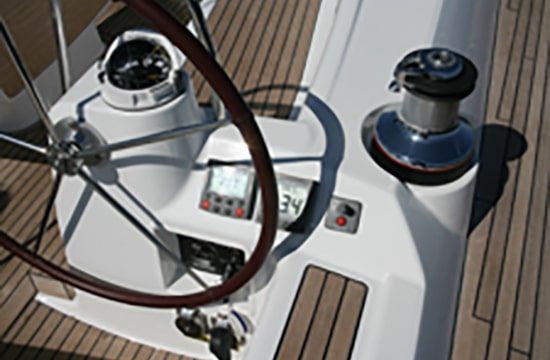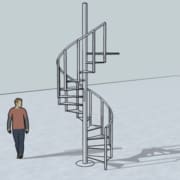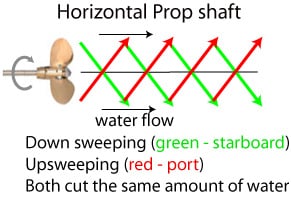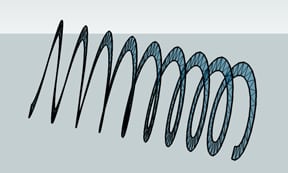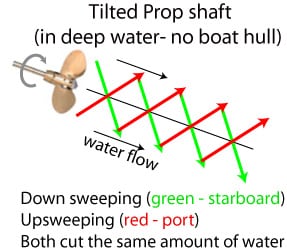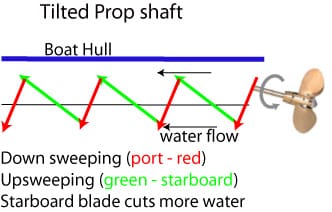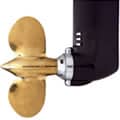Propwalk factors – The p factor
There are two combined reasons that work in unison to create Propwalk. And they are not what you might think. The two effects are the p-factor and the wash-lift factor.
The p-factor
This is the exact same effect that airplanes with propellers feel on take off at the time when the pilot pulls back on the yoke. At this time, the plane is moving horizontally but the props are pointed at an angle to the sky. The down-swinging blade is chopping air at a different angle than the up-swinging blade. The pilot feels a strange phenomenon and counters it by applying the rudder to stop the plane yawing (propwalking).
To understand this, imagine you’re walking up a spiral staircase. Each step is the same height and requires the same amount of energy to go up to the next step.
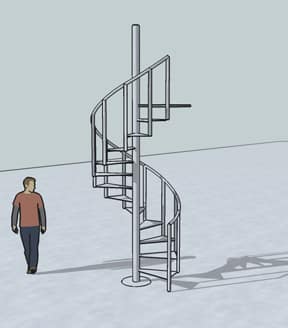
Now imagine the spiral staircase was tilted over 20 degrees. You’d find that as you went around the stairs they would be steeper on one side and flatter on the other. Or the steeper side would cut through more vertical space than the flatter side.
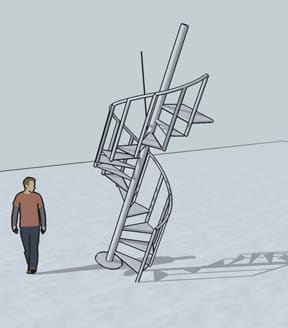
As we look at a propeller and the water flowing through it, the arc that the tips of the propeller follow relative to the moving water pushed by the propeller is a spiral shape, much like a spiral staircase.
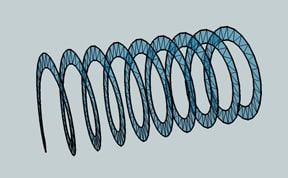
Another way to see it is to observe the sweep of each blade as it passes through the water.
Now, if we tilt the shaft of the propeller down, the spiral also tilts down.
But we have to put a few prefaces on this: There must be no boat hull above to affect the initial flow of water; the water must be deep; and the propeller cannot be moving horizontally through the water—that’s a lot of prefaces and not reality. But here is what that would look like anyway.
Now put the propeller in close to the hull of the boat where the water tends to move horizontally. This is represented by the imaginary sweep lines. Here you can see that the upswinging reversing blade (in green – starboard) cuts more of the flowing water, similar to the tilting staircase example above.
In much the same way as the tilting staircase, the down-sweeping blade cuts through less flowing water than the up-sweeping blade. This creates more force on the upswinging side of the propeller than the downswinging side, and thus a torque is produced on the prop shaft.
This results in the following forces and a resultant clockwise (looking from an above position) torque on the boat.
In a similar fashion, imagine yourself treading water in a swimming pool, and your right arm swings in big circles while your left swings in smaller circles. Your body would move backward, but the action would also turn your face to the right and consequently your back to the left. The boat turns in exactly the same way.
In forward gear, the exact same phenomenon occurs, just in the opposite direction. However, we notice it much less because the water from the propeller is being pushed over the rudder, which creates far greater forces and thus counteracts any tilt-induced torque.
So in summary, a boat that has a counter-rotating shaft, when in reverse, yaws clockwise (stern to the left) because the shaft is tilting downwards. Factors to reduce the effect include having a smaller diameter propeller or reducing the pitch (twist) of the blade or lengthening the shaft so that the water flow is further from the boat, which would tend to allow the water flow to be more in line with the shaft. The effect is also reduced by a slower turning propeller, that is, less engine rpm.
An alternative way of mounting the propeller is called a “sail drive,” and these are widely seen in Europe. Saildrive systems have a horizontally mounted propeller shaft and therefore they do not create prop walk from the p-factor effect.
But there is no need to go to the expense of converting your boat to a sail drive unit if you are experiencing frustration with prop walk. Because now that you understand the theory, (more than 90% of sailors do not) all you have to do is practice the coming exercises a few times and you’ll have it licked.

